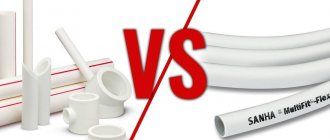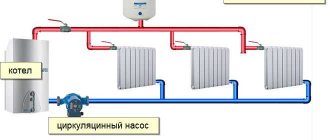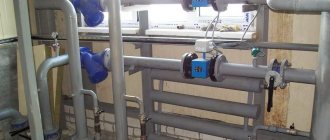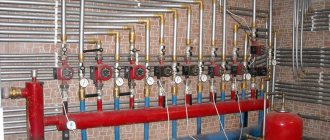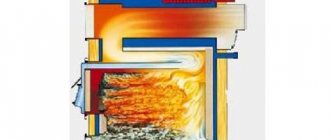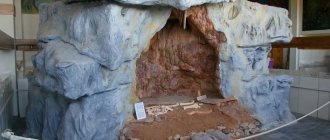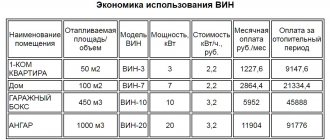Elements of a manifold heating circuit
Radiant heating of a private house is a structure consisting of several main elements:
- Heating boiler
. This device is the starting point, since from it the hot coolant is directed into pipelines and radiators. The power of the heating unit must correspond to the heat output of the heating equipment. There is the following nuance here: the radial layout of the heating system, unlike other pipeline layout options, has a greater degree of heat loss, which must certainly be taken into account when calculating equipment parameters. - Circulation pump
. According to the peculiarities of its design, radiant heating distribution is of the closed type and its operation requires forced circulation of the coolant liquid. For this purpose, a special pump is installed that creates a certain pressure and pumps the liquid. As a result, the required temperature conditions are ensured, guaranteeing efficient operation of the heating system.
When choosing a circulation pump for radiant heating, you should pay attention to a number of parameters, including the length of the pipelines and the materials used to make the radiators. In addition, the power of the pump is not one of its most important characteristics; the speed at which the liquid will be pumped should be taken into account
This parameter shows the volume of coolant moved by the circulation device per unit of time
In addition, the power of the pump is not one of its most important characteristics; the speed at which the liquid will be pumped should be taken into account. This parameter shows the volume of coolant moved by the circulation device per unit of time.
Collector
(it is also called a comb). It is also an important element of the radiant wiring of the heating system. The comb is assigned the function of a distribution device designed to centrally supply heating radiators with coolant (more details: “Distribution comb of the heating system - purpose and principle of operation”).
The radial circuit of a heating system always contains a variety of thermostatic or shut-off and control elements. They provide the necessary flow of thermal energy carrier in each branch of the structure. The installation of thermometers and air removers operating in automatic mode will help create additional conditions for more efficient operation of the heating structure without unnecessary costs.
Collectors on the domestic market are offered to consumers in a wide range. The choice of a specific device is based on the number of designed heating circuits or connected radiators. Combs are made from various materials - it can be brass or steel, as well as polymer products.
Cabinets
. The radiant heating scheme requires that all the elements included in it be located in special structures equipped for them. Distribution manifold for heating. shut-off valves and pipelines must be placed in manifold cabinets of a simple design. They can be built into niche walls or external, but at the same time they are distinguished by functionality and practicality.
The principle of organizing a beam circuit
One of the central elements of the beam system is the collector unit. If you are going to do heating in a house with several floors, then the collector should be located on each level.
During installation, collectors are placed in a collector cabinet, where a convenient system for positioning this element is provided for subsequent maintenance or adjustment.
The radial wiring diagram is used for one- and two-pipe systems. The first option assumes that the supply and collection of coolant is carried out by one collector. The second option involves the use of two collectors for supply and return
The indisputable advantage of the radial system is the minimum number of connections, which has a positive effect on the hydraulic stability of the entire heating system. The central working body is the boiler.
To ensure high efficiency and safety, the owner needs to take into account the power of the unit, the consumption of thermal energy by heating devices and the heat loss of the system. This must be done regardless of what type of fuel the boiler operates on.
An increase in the length of the pipeline when creating radial distribution is fraught with a slight increase in heat loss, which also needs to be taken into account for power balance.
In single-pipe radial distribution of heating circuits, the supply of coolant prepared for heating devices is carried out by the same collector, which collects the return and sends it to the boiler (+)
Choosing a circulation pump
Radial piping is used mainly in horizontal circuits with bottom coolant supply. It requires a circulation pump that stimulates the movement of heated water through numerous branches.
Controlled coolant circulation makes it possible to reduce the temperature difference at the inlet and outlet of the heating circuit. As a result, it is possible to increase heating efficiency, making the system more compact and less material-intensive.
When selecting and installing a circulation pump, you need to take into account a number of features, using which you can achieve high efficiency of the entire system.
This unit is selected according to several important parameters, including:
- productivity, m3/hour;
- head height, m.
To correctly select a circulation pump for these parameters, you need to take into account the diameter of the pipes, their length and height relative to the level of the pumping unit. When drawing up a heating system installation project, these parameters are calculated in advance.
Rules for installing a circulation pump
By adhering to the recommendations below, you can achieve high heating efficiency and safety:
- circulation pumps with a wet rotor are installed so that the shaft is horizontal;
- the device with a thermostat should not be close to hot surfaces (radiator or boiler) so that the readings are not distorted;
- as a rule, it is installed on the return section of the pipeline due to lower temperatures. Modern models can also be installed in the supply line, withstanding high temperatures;
- The heating circuit must be equipped with an air bleed mechanism. If there is none, then the pump must have an air vent;
- should be located as close as possible to the expansion tank;
- Before installing the pump, it is recommended to flush the system to remove solids;
- Before starting the pump, fill the system with water;
To avoid becoming a victim of excessive noise, select a pump in accordance with the performance of the heating system.
Is it possible without a pump?
Of course, you can save money and not buy a pump, air vents for bleeding air, sensors, etc. But a beam system with natural circulation requires compliance with several not very convenient conditions.
Experts recommend this option in extremely rare cases. Firstly, you will need to install wide diameter pipes. Secondly, the expansion tank must be installed at the highest point of the facility.
To save on components, you can do without a pump, but this is only possible if a number of conditions are met and only for small buildings
This option is suitable for a cottage or other modest-sized object, providing enough heat. The choice between natural circulation and forced circulation must be made at the design stage.
Selecting a distribution manifold
This device is also called a distribution comb. Serves to supply coolant to each heating device (warm floor, radiator, convector, etc.). Through the collector, the return flow also occurs, which then enters the boiler or is again mixed into the circuit to regulate the temperature.
The collector can support from 2 to 12 circuits. Some manufacturers offer even more branches for complex projects.
The distribution manifold is the main transport terminal, which serves to distribute the coolant in the right quantity for each room or heating device
Combs are often equipped with additional shut-off and temperature control elements. They allow you to configure the optimal coolant flow for each heating branch. The presence of air extractors guarantees more efficient and safe operation of the system.
Manifold cabinets and blocks
In an apartment with horizontal radiant heating distribution (on the floors of private houses), distribution manifolds (supply and return) are installed, collecting all supply and return pipelines at their outlets. They are placed in specially designed metal cabinets, often built into the partitions of bathrooms and opening inside them. It is also possible to install distribution manifolds in specially designed wall niches. Often the collector unit is combined with a heat metering unit in one collector cabinet.
Manifold cabinet with thermal energy metering unit.
Collectors can be complete, consisting of sections of thick pipes with outlet pipes, or assembled on tees. The materials for these devices can be:
- plastic;
- nickel plated brass;
- copper;
- stainless steel.
Many well-known manufacturers of heating equipment (VALTEC, etc.) produce ready-made manifold blocks that combine supply and return manifolds, manual adjustment valves (on the supply manifold), thermostatic valves (on the return manifold), automatic air vents, drain valves and mounting brackets.
Complete collector block.
The task of individually adjusting the thermal regime of each single-radiator branch of a collector-radiant heating system is solved by tuning valves with built-in flow meters. The branches are of different lengths, and the coolant tends to flow the shortest way with minimal hydraulic resistance. It flows more intensely around short branches, warming up the radiators installed there more strongly.
Adjustment valves on the supply manifold change the flow of water (antifreeze), narrowing their nominal passages in short circuits, and widening them in long ones. Setting up is a painstaking process, and the setting valve is not intended to quickly shut off or open the coolant flow along the circuits. This function is performed by thermostatic valves.
Thermal valves on the manifold – “return” – are valves that smoothly shut off the flow manually or automatically. The radiant heating system is easily hydraulically balanced.
Features and diagrams of a beam system in an apartment building
The main difficulty of using a collector-radial circuit in an apartment building, in which the coolant is supplied according to a traditional vertical two-pipe circuit, is the influence of the radial circuit of an individual apartment on the heat load of the apartments above, in which this circuit is not implemented. Such apartments will not receive enough heat.
There are some ways to connect the collector to the common house system without harming the neighbors.
Use of a heat exchanger in a radiant system
The heat exchanger has no hydraulic resistance and is connected like a simple radiator through which the coolant passes without the participation of a circulation pump.
Option for connecting the collector to central heating via a heat exchanger
Heat flows passing through the collector circuit in which the heat exchanger is installed do not mix with the central heating coolant.
Connection with primary-secondary rings
With this connection, the central heating system of the house serves as the primary ring, and the collector-radiant heating system plays the role of the secondary ring.
The connection is made to the pipeline coming from the convector.
The algorithm for constructing such an insert is as follows:
- To directly supply coolant to the collector, the first cut is made at a distance of 30 cm from the radiator jumper.
- The return contour line is cut in at a distance of 60 cm from the jumper.
- Shut-off valves are mounted on the tie-ins.
- A three-way valve and pump are installed.
- A valve is mounted on the return pipe, through which coolant flows in only one direction.
Hot water passes through the collector through loops of the circuit, then part of it is supplied to the central heating return pipe, and part is returned to the collector through a three-way valve. This valve is responsible for the distribution of coolant.
With this scheme, the coolant is withdrawn evenly, without creating a vacuum in the central heating pipeline and without changing the heat balance of the apartments.
To insert into the common heating riser of a residential building, individual design and permission from the management company are required.
Features of a radiant home heating system
However, there is one more point that should not be overlooked. This is adjustment or regulation. It is carried out precisely in regulating the taps located on the manifold. But it is also worth saying that such a system is inconvenient because you have to constantly adjust the modes, which is not always possible physically. In addition, if you have a fairly large building, then it is better to abandon this idea.
The fire is the first direct descendant of radiant heating, and the Russian stove is a vivid example of this. Large, occupying a significant space, it was capable of heating the house with its infrared radiation, or, simply put, with living heat. If the room is warm, then heat radiation as such does not occur, and the person feels comfortable. And if it has cold walls, ceilings and other interior items, to a greater extent, it is on them that the infrared rays emitted by a person are transmitted. Surely, anyone can remember the chills running through the body, it would seem, in a warm room. This is radiant heat exchange, on the principle of which the radiant heating system of a house is built.
Advantages
The main advantages of a radiant heating system are as follows:
- simple heat flow control;
- simple regulation of circulation;
- saving resource consumption;
- relatively inexpensive cost.
Advantages are those properties that improve or simplify the control or operation of heat flow. Regulating the temperature in each room is not only convenient, but also economical in terms of resource consumption. You save a lot of time, since the overall scheme is very simple.
Another advantage of this method is the possibility of using polypropylene and metal-plastic pipes instead of steel ones. This significantly reduces the cost of materials and allows you to choose any finishing design, since plastic pipes can often be hidden behind the walls.
An important advantage of using radiant heating system wiring is its compatibility with the installation of heated floors.
Metal-plastic pipes.
The radiant heating system allows you to completely avoid water hammer, which is important for expensive plumbing fixtures that cannot withstand high pressure.
Review of diagrams and components of the heating system
At the first stage, you need to choose the operating principle of the heating system. Even 20-25 years ago there was practically no alternative - they made a gravitational open system. Therefore, the question of how to properly install heating came down to choosing the diameter of steel pipes and their correct slope. But the appearance on the market of the main elements of a closed system has significantly expanded the possibilities for choosing a scheme.
Gravity heating system
Gravity heating circuit
The main source of water heating for it is a solid fuel boiler (it can run on diesel or waste oil). Installation of gas models is impossible, since their normal functioning implies increased pressure in the pipes. Independent installation of a heating system with a gas boiler is possible. But in this case, a solid fuel housing is used, into which a special gas burner is mounted.
Before properly installing heating in a private home, you need to select its main components. In addition to the boiler, the following elements are required:
- Pipes. For this type of heating, you can use plastic models (polypropylene, metal-plastic) or steel. It is best to choose a large diameter - from 40 mm. In this way, the overall hydraulic resistance can be reduced;
- Expansion tank. Necessary to stabilize the system in case of overheating of the coolant;
- Shut-off valves. Its installation is mandatory, since during repair or maintenance work it will be necessary to shut off the coolant flow in a certain area of the system;
- Feeding unit. Required to add coolant. For optimization purposes, it is often included in the design of the expansion tank.
Radiator kit for single-pipe heating system
The gravity system in most cases is made of one pipe (Leningrad). In order to properly install the heating radiator, it is necessary to install a bypass on each of them. This also needs to be taken into account when purchasing components and drawing up a general installation diagram.
In addition to these components, the installation of pressure gauges is required. If this device is not provided in the boiler design, it should be installed on the outlet pipe.
To mount a heating radiator, it is necessary to provide it with a Mayevsky tap. It is necessary to eliminate air locks in the system.
Diagram of a forced circulation heating system
Closed heating circuit with solid fuel boiler
It is much more difficult to install a heating system with forced circulation. The difference lies in the creation of increased pressure in the line. This helps to increase the length of pipelines and optimal temperature conditions for the operation of the entire system.
It is best to consider the configuration of this circuit using the example of piping a solid fuel boiler. Since most gas models have the vast majority of components included in the design (circulation pump, expansion tank, etc.). Therefore, in order to install a heating system yourself, in addition to the boiler, the system must contain:
- Circulation pump. It will create the required level of coolant pressure;
- Closed expansion tank. Serves as a compensator when the pressure in the system increases above critical;
- Security group. Partially duplicates the functions of the expansion tank. If the pressure is too high, the air vent and drain valve will reduce it, removing excess air and coolant from the system;
- Shut-off valves;
- Feeding unit.
How to install a closed-type heating system yourself, and most importantly, what pipe layout to choose? Experts recommend installing a two-pipe system, since in this case the radiators will be connected in parallel, which will ensure uniform temperature distribution throughout the system.
Installing a forced-type heating system is much easier than with natural circulation. In addition, the first is the only option for houses with medium and large areas.
Types of heating schemes: what is their difference?
The most popular are two schemes: one-pipe and two-pipe with different types of wiring.
Single-pipe heating scheme for a one-story house
Single-pipe heating circuit
This type of scheme is the simplest and most accessible. The coolant is water, and its movement through the pipes is ensured by natural circulation. In this case, pipes with a sufficiently large diameter should be used. To improve the work result and using a more compact pipeline (in diameter), you can use a special circulation pump. This is necessary in case of real estate with a large area.
The water heated in the boiler enters the pipeline to further enter the radiators. It is here that it gradually cools down, giving up its heat, and returns the same way.
At the highest point, which in most cases is located in the attic, an expansion tank is mounted. Without exaggeration, this heating system can be considered the simplest and most economical among other types.
The disadvantages of the system include two factors:
- The temperature of the radiator battery, which is closer to the boiler, will be higher than that of distant heating devices. The water cools down on its way and gives off less heat to each subsequent battery.
- It is impossible to control the operation of a single radiator battery. If a heating element breaks down, the entire system will shut down.
This heating scheme for a one-story house has its advantages:
- Economical heating option;
- Quick and easy installation, you can do it yourself;
- All heat is spent on heating the house, its losses are excluded;
- If the pump malfunctions, circulation can occur naturally.
Two-pipe heating scheme for a one-story house
The system is quite actively used in private houses of any number of floors. Its characteristic features are separation of the coolant circuit and uniform heating of the entire area. Water or other coolant passes through the supply pipe from the boiler to radiator batteries, a “warm floor” system, or for household needs. And after cooling, it returns back to the boiler, but through a different pipe.
A two-pipe heating system for a one-story house has the following positive aspects:
- Ability to regulate the operation of heating elements;
- Efficiency of work in any private houses that belong to low-rise construction;
- If one radiator breaks down, there is no need to shut down the entire system;
- You can get hot water for your needs.
Among the disadvantages, it is worth highlighting the large number of pipes, which do not add aesthetics to the design, but, on the contrary, reduce it. In addition, a two-pipe heating scheme for a one-story house requires a more complex installation process and the purchase of more materials and equipment.
Which scheme should I choose?
Operating principle of two-pipe and one-pipe systems
The choice of heating scheme for a private one-story house can be based on various factors that depend on each specific situation. But among the general criteria, one can highlight the living space of the house, the characteristics of the materials that were used in its construction, as well as the type of residence (permanent or seasonal). The degree of autonomy of the system plays an important role. It is necessary to take into account which external connection the entire system will operate from, the availability of communications and other factors.
It is believed that the optimal heating scheme for a one-story house is a horizontal two-pipe system. It will allow you to evenly distribute all the heat in the house and create optimal temperature indicators.
Manifold selection
The radiant heating system includes a collector (comb). This element looks like a pipe. It has pipes for inlet and outlet of coolant. For a beam circuit, two types of collectors should be installed.
The first of these will be the input comb. A pump is connected to it, as well as a coolant distribution valve. It can be three- or two-way. The valve contains a thermometer. It is installed in the collector housing. The device transmits information to the valve. It opens or closes the valve, mixing hot liquid into the circuit.
The outlet manifold collects the cooled coolant, which returns to the boiler. The heating device heats it up again. Additionally, a balancing flow controller can be installed on this pipe. The collector group ensures the stability of the system. It is responsible for optimizing and balancing the heating of the coolant in the system.
Pros and cons of the beam system
It is best to weigh all the pros and cons before installing a heating system and decide in advance which system will suit you best. Of course, the beam system has its own characteristics, which also need to be taken into account. Let's start with the negative points.
Disadvantages of the beam system
- This system has, perhaps, only one drawback - it is a larger number of elements in its design. In particular - pipes. It also uses more fittings;
- A large number of elements in a given system can increase repair costs. A conventional heating system has a lower estimated cost and is cheaper to repair.
A radiant heating system for a private home requires a more correct approach when connecting all heating devices, since violation of the connection rules is fraught with frequent breakdowns of the system as a whole.
Pros of the beam system
But all of the above loses its significance against the background of the general advantages of a radiant heating system. In a very short period of time, a properly designed and installed beam system:
- It will more than pay for itself. It also has a lot of useful and convenient features;
- When using a radiant heating system, you can have a differentiated approach to heating in each room. This approach allows you to more efficiently distribute heat in your home, which entails very large energy savings;
- This system is also convenient in that during its repair you can get unhindered access to pipe connections, which speeds up the identification of problems and their elimination;
- In a traditional heating system, hiding pipes is not very easy. The radial system allows pipes to be hidden from view either in the walls or under the floor. If this system is installed correctly, then no components or wiring will be noticeable;
- The correct radial distribution scheme allows you to effectively distribute heat throughout the entire area of your home.
Single-pipe horizontal
The simplest version of a single-pipe horizontal heating system with a bottom connection.
When creating a heating system for a private house with your own hands, a single-pipe wiring diagram may turn out to be the most profitable and cheapest. It is equally suitable for both one-story and two-story houses. In the case of a one-story house, it looks very simple - the radiators are connected in series to ensure consistent flow of coolant. After the last radiator, the coolant is sent through a solid return pipe to the boiler.
Advantages and disadvantages of the scheme
First, we will look at the main advantages of the scheme:
- ease of implementation;
- excellent option for small houses;
- saving of materials.
A single-pipe horizontal heating circuit is an excellent option for small spaces with a minimum number of rooms.
The scheme is really very simple and understandable, so even a beginner can handle its implementation. It provides for a serial connection of all installed radiators. This is an ideal heating layout for a small private house. For example, if this is a one-room or two-room house, then “fencing” a more complex two-pipe system does not make much sense.
Looking at the photo of such a circuit, we can note that the return pipe here is solid, it does not pass through the radiators. Therefore, this scheme is more economical in terms of material consumption. If you don’t have extra money, this type of wiring will be the most optimal for you - it will save money and allow you to provide heat to your home.
As for the shortcomings, there are few of them. The main disadvantage is that the last radiator in the house will be colder than the very first one. This is due to the sequential passage of the coolant through the batteries, where it releases the accumulated heat into the atmosphere. Another disadvantage of a single-pipe horizontal circuit is that if one battery fails, the entire system will have to be turned off at once.
Despite certain disadvantages, this heating scheme continues to be used in many small private houses.
Features of installation of a single-pipe horizontal system
When creating water heating for a private house with your own hands, the scheme with single-pipe horizontal wiring will be the easiest to implement. During the installation process, it is necessary to mount the heating radiators, and then connect them with pipe sections. After connecting the very last radiator, it is necessary to turn the system in the opposite direction - it is advisable that the outlet pipe runs along the opposite wall.
A single-pipe horizontal heating circuit can also be used in two-story houses; each floor here is connected in parallel.
The larger your home, the more windows it has and the more radiators it has. Accordingly, heat losses also increase, as a result of which the last rooms become noticeably cooler. You can compensate for the temperature drop by increasing the number of sections on the latest radiators. But it is best to install a system with bypasses or with forced circulation of the coolant - we will talk about this a little later.
A similar heating scheme can be used to heat two-story houses. To do this, two chains of radiators are created (on the first and second floors), which are connected in parallel to each other. There is only one return pipe in this battery connection diagram; it starts from the last radiator on the first floor. The return pipe coming down from the second floor is also connected there.
What types of heating systems are there for an apartment building?
Depending on the installation of the heat generator or the location of the boiler room:
- An autonomous system in an apartment where the heating boiler is installed in a separate room or in the kitchen. The costs of purchasing a boiler, radiators and corresponding materials for piping are returned quickly, since such an autonomous system can be adjusted based on your own considerations regarding the temperature regime in the house. In addition, an individual pipeline does not lose heat, but on the contrary, it helps to heat the premises, since it is laid throughout the apartment or house. An individual boiler does not need to be adapted for the reconstruction of central heating - once drawn up and implemented, the heating scheme will work for a lifetime. And finally, the already working circuit can be supplemented with parallel or sequentially connected circuits, for example, a “warm floor”;
- An individual heating option that is designed to serve an entire apartment building or an entire residential complex is a mini-boiler room. Examples include old boiler houses serving a neighborhood, or new complexes for one or more houses using different energy sources - from gas and electricity to solar panels and thermal springs;
A centralized heating scheme in a multi-storey building is still the most common working solution to the problem.
Heating schemes depending on the parameters of the working fluid:
- Heating using ordinary water, in the pipes of which the coolant does not heat above 65-70C. This is a development from the field of low-potential systems, but most often old circuits work with a working fluid temperature reaching 80-105C;
- Steam heating, where not hot water moves through the pipes, but steam under pressure. Such systems are becoming a thing of the past, and today they are practically not used in the delivery of heat and heating of any type of apartment buildings.
Based on the piping diagram:
- The most common is a single-pipe heating system for a multi-story building, where both supply and return pipes are one thread of the heating main. Such a scheme can still be found in “Khrushchev” and “Stalin” buildings, but in practice it has a big drawback: batteries or radiators connected in series to the circuit do not ensure uniform heat transfer - each subsequent heating device will be a little colder, and the last radiator will be a little colder. the pipeline will be the coldest. For at least approximately equal distribution of heat throughout the rooms, each subsequent radiator in the circuit must be equipped with a larger number of sections. In addition, in a single-pipe heating scheme in a five-story building, you cannot use radiators that do not meet the design parameters, and devices for regulating heat transfer - valves, etc. regulation;
- The Leningradka scheme is a more advanced solution, but according to the same single-pipe scheme. This scheme has a bypass (pipe jumper), which can connect or disconnect additional heating devices, thereby regulating the heat transfer in the room;
A more advanced two-pipe heating system in an apartment building began its existence with the construction of buildings according to the so-called “Brezhnevka” project - a panel house. The supply and return in such a scheme operate separately, so the temperature of the working fluid at the inlets and outlets of the apartments of a 9-story building is always the same, as in radiators or batteries. Another plus is the possibility of installing an automatic or manual control valve on each heating device; The radial (collector) scheme is the latest development for atypical housing. All heating devices are connected in parallel, and taking into account the fact that this is a closed OO system in an apartment building, the piping can be made hidden. When implementing a beam scheme, all control devices can limit or increase the heat supply in dosed quantities.
Radiant heating system for a two-story house is the best choice
At the moment, a more efficient and economical floor heating system for two-story private country houses than a two-pipe radial scheme simply cannot be found. By choosing the equipment correctly, as well as calculating all the nuances and performing installation as required by the instructions, you can ensure comfort and coziness in your home.
It is important to point out the fact that the main heating devices in a radial double-circuit system are traditional radiators. Regardless of the size and material (and this can be either cast iron or aluminum), such units must be installed correctly:
Regardless of the size and material (and this can be either cast iron or aluminum), such units must be installed correctly:
- Heating radiators must be installed only under window openings;
- All heating radiators must be mounted at the same height;
- The fins of the battery are located only vertically - otherwise normal coolant circulation will be impossible;
- It is imperative to provide a drain system through which the coolant will be replaced.
Two-pipe heating system for a house with two floors
The boiler also means a lot (see how to choose a gas heating boiler)
For normal operation of the double-circuit system, it is important to choose modern and efficient boilers. Such equipment (and even equipped with automation) will make it possible to ensure optimal heating of each room of a two-story house, significantly saving fuel and money and obtaining hot water
The heating system of a two-story building with a two-pipe radiant heating circuit is not only quite productive and efficient, but also demanding for the first start-up.
For example, before starting direct operation, it is important to correctly balance the system and adjust the fluid flow for each loop of supply and return pipelines. This is the only way to achieve fuel savings and ensure the highest possible level of heating
What do experts recommend?
When installing radiant heating, you must follow the advice of the experts:
- air vents must be installed both on the direct and return flow of the collector;
- The optimal location for installing the compensation tank is on the return pipeline, before the circulation pump.
- It is better to install circulation pumps on each circuit.
Installing pumps on the return line, where the coolant temperature is lower, will slightly increase their service life.
Circulation pumps in the heating system
Equipping a home with a radiant heating system, despite its apparent complexity and cost, in fact, if all technologies and recommendations are followed, will be a winning solution both in terms of energy efficiency and the comfort provided.
Modern heating systems
Quite a lot of time has passed since the time of the Russian stove, and although it is an ideal option for radiant heating at home.
but at present, installing it in a city apartment is nonsense. But technology is also developing every day, so all heating systems, including radiant ones, installed both in private houses and apartments, are mostly the most modern and adapted to the needs of each person. Heating systems are primarily divided according to how pipes are routed from the collector to the radiators. These are several types of systems such as;
- Single-pipe;
- Two-pipe;
- Radial;
The principle of radiant heating is that wiring from the collector, the main coolant distributor, is intended for each radiator separately. This is the most significant advantage in this system - radiators can be turned on and off, either individually or as a group.
In addition, the heat supply valve can be adjusted. For example, if the kitchen does not require such an amount of thermal radiation due to the operation of household appliances that serve as an additional source of heat, then the valve can be screwed on. This can be done so that heat flows into the kitchen, but not in such quantities as into the rest of the rooms. The same can be done with those rooms that are not used for their intended purpose, but they must remain warm. By regulating the heat supply, fuel economy also increases. and due to this, the heat meter readings are also encouraging.
Radiant system with heated floor
As many may have noticed, a radiant heating system is installed on the same principle as a water heated floor. In theory, you can connect a warm floor to radiators through one comb. This method will be especially in demand by those who want to install heated floors in some rooms and radiators in others.
If you make a radial system together with heated floors, it will work. But keep in mind that heated floors are a low-temperature system, and radiators are a high-temperature system.
If you don’t think about adjusting the temperature, then in one case with heated floors in the room you will be hot, in another case with radiators it will be cold. Keep this in mind.
There is another positive side property of the collector heating system. Namely, a comfortable heated floor. The fact is that when radiant heating systems are installed, the distributor is mounted closer to the risers or the center of the room. In this case, pipelines from the distributor to the radiator in 99 percent of cases pass through corridors and enter rooms through doorways.
Yes, the pipes in this case are insulated with pipe insulation in one layer. But many installers know that 6-9 mm thick insulation allows up to 30 percent of heat to pass through.
That is why, where the pipes of the radiant heating system of the house pass, the floors are not cold, but comfortably warm. With one heating system we catch two birds with one stone. We get a reliable heating system without joints in building structures and comfortable heated floors.
How is a multi-storey building heated?
- Operating principle of the elevator unit
- About the heating system of a multi-storey building
The heating system of a multi-story building is of particular interest; it can be considered using the example of a standard five-story building. It is necessary to find out how heating and hot water supply function in such a house.
Heating diagram for a two-story house.
A five-story building requires central heating. the house has a heating main inlet, there are water valves, and there may be several heating units.
In most houses, the heating unit is locked, which is done to achieve safety. Despite the fact that all this may seem very complicated, the heating system can be described in simple words. The easiest way is to take a five-story building as an example.
The heating scheme for the house is as follows. After the water valves there are mud traps (there can be only one mud trap). If the heating system is open, then after the mud traps through the inserts there are valves that are located from processing and supply. The heating system is designed in such a way that water, depending on the circumstances, cannot be taken from the back of the house or from the supply. The thing is that the central heating system of an apartment building operates on water that is superheated, the water is supplied from a boiler room or from a thermal power plant, its pressure ranges from 6 to 10 kgf, and the water temperature reaches 1500°C. Water is in a liquid state even in very cold weather due to increased pressure, so it does not boil in the pipeline to form steam.
When the temperature is so high, the hot water supply is turned on from the back of the building, where the water temperature does not exceed 700°C. If the temperature of the coolant is low (this happens in spring and autumn), then for the normal functioning of the hot water supply this temperature cannot be sufficient, then the water for the hot water supply comes from the supply to the building.
Now you can disassemble the open heating system of such a house (this is called an open water intake), this scheme is one of the most common.
Analysis of the arguments "for" and "against"
Let's start with the cons. In addition to the material consumption, which affects the cost of the project, there is the need to install a manifold cabinet, which will require additional space.
This is where the disadvantages of the beam system end, and a series of advantages begin:
- simple design and installation, the system uses pipes of the same diameter;
- with hidden installation there are no connections in the walls and floor;
- high installation speed due to the minimum number of connections;
- expansion of functionality due to the installation of shut-off valves, sensors, air vents and thermal heads to automate the operation of the heating system;
- temperature control in each individual room using mechanical elements or automation;
- the ability to cut off any radiator without stopping the heating process;
- uniform heating of all rooms.
The external control panel allows you to program the heating operation, including automatic adjustment depending on the weather conditions outside. Thanks to the installed sensors, all residents can set any parameters that are comfortable for them while in a specific room.
The radiant system is materially expensive in terms of implementation, but is ahead of all other options in flexibility of settings and ensuring the efficiency of all heating
Thus, the radial wiring diagram makes it possible to achieve high controllability of the heating system and achieve optimal coolant flow.
Types of radiant heating system
A visual diagram of the heating system in a private house.
A radiant heating system in a private house can be installed with either forced or natural circulation of the coolant. Currently, a system with natural circulation is used very rarely, since it requires the use of pipes with a very large diameter, which is not very convenient for a private home. In addition, this system is equipped with an expansion tank, the installation of which is necessary at the highest point of a two-story house, which again is not entirely convenient. But at the same time, a radiant heating system with natural circulation will help save on installation, since it will not require additional expensive equipment (pumps, temperature sensors, air vents, etc.).
The collector heating system with forced circulation is the most widely used; its main advantage is the artificial circulation of heat through pipes. For these purposes, a special pump is installed in the supply or return line. Forced circulation makes it possible to reduce the temperature difference between the water inlet and outlet, and also simplifies the heating system itself, which makes it more compact and helps to avoid unnecessary consumption of materials. This heating system is absolutely independent of the design of the house and the location of the heated rooms in it. The hydraulic resistance of the pipeline and the length of the branches do not play a special role. And by installing modern automatic devices, you can change the temperature depending on weather conditions and the individual wishes of the residents. All these advantages make this system universal.
Selection of pipes for the heating system
The most common for installing heating systems in two-story houses are metal-plastic pipes. This is primarily due to the fact that no sediment is deposited on products made of polymer materials and they are resistant to corrosion. A rather low price is another advantage of metal-plastic pipes. All connections are made without welding using threaded or pressed connections, which simplifies installation as much as possible. However, such pipes have one drawback - a high coefficient of thermal expansion, which, if used incorrectly, can lead to leaks.
Pros and cons of radiant heating systems
The disadvantages of radiant heating in a house include:
- a large number of materials and, as a result, higher cost;
- the need for a special place for the collector block.
The advantages of the beam system are:
ease of installation due to the small number of connecting elements; hidden pipes in the floor; hydraulic stability, which is especially important when using imported plumbing fixtures; the ability to turn off each radiator individually, while all others are operating as usual; temperature control in each individual room; the system is balanced, all rooms are heated evenly.
When developing a project for a radiant heating system, it is necessary to detail it as much as possible; this will significantly simplify installation and help avoid problems in the future. It should also be noted that actual costs will always exceed planned costs; this must be taken into account when drawing up estimates. But, despite everything, the radiant heating system is highly efficient and can create maximum comfort in a living space.
Differences from a two-pipe system
Two-pipe heating system
Autonomous heating systems are becoming increasingly popular among people. They have a lot of different wiring options. Until recently, conventional autonomous heating systems were used, but more recently they have been replaced by radiant heating systems. They are also popularly called collectors. The name speaks for itself, since individually each radiator is connected directly to the collector, which distributes the coolant. With this connection of radiators, they are completely independent of each other. In a radiant heating system, other heating devices can be used, which also do not depend on radiators in this system. The radiators here are connected in parallel to the collector. As a rule, the collector is mounted somewhere in a remote part of the room, or hidden in a wall, or in a special cabinet. The collector is sometimes quite large. It all depends on the area of the heated room. The beam system allows you to easily repair a failed radiator without stopping the entire system. A radiator in need of repair should simply be disconnected from the heating system and dismantled.
A conventional heating system uses a two-pipe circuit. It is also called tee. To install this autonomous heating scheme, much fewer pipes are required than for radial heating. But the additional costs for pipes in the beam system are more than recouped due to energy savings. The radiant heating system most clearly reveals its economic effect in residential premises with a large area, especially in multi-storey private buildings.
Types of beam wiring
Method 1. With forced water circulation
Previously, a radiant heating scheme equipped with pumps that pump water was not very popular due to the high cost of parts. But now the price of equipment has dropped significantly, and more and more people are choosing it.
The main difference from the gravitational scheme is that liquid (water or antifreeze) flows from the boiler to the batteries and back not due to the difference in temperature and pressure, but with the help of pumps.
This results in the following benefits:
- there are no restrictions on the geometry and number of rooms in housing construction;
- heating can be installed in rooms of any size;
- To connect radiators and collectors, you can use pipes of any length, laid without a slope.
One of the elements of a radiant heating system with forced circulation is a pump
Advice! Despite the fact that the circulation pump can be installed at any point in the system, it is advisable to do this on the return manifold before supplying coolant to the boiler. There the liquid temperature is the lowest, which has a positive effect on the service life of the equipment.
Method 2. With natural water circulation
In this case, the coolant moves due to gravity: the heated water becomes less dense and lighter, therefore it is displaced to the upper point of the system, after which, as it cools, it flows through the collectors and radiators, and then returns to the heater.
The gravity beam heating system has the following features:
- During installation, an open expansion tank is required, installed at the highest point. It compensates for the thermal expansion of the coolant and prevents an increase in internal pressure in the pipelines.
- A radiant heating network with natural circulation does not require the installation of expensive electrical equipment, which significantly reduces the estimated cost of work.
- Heating with natural circulation is completely energy independent. Even if there is a power outage, which often happens in summer cottages or in rural areas, you will not be left without heat.
The gravity heating system does not use pumps
Types of water heating
Water heating can be of two types:
- With natural coolant circulation.
- With forced circulation.
Let's look briefly at each type.
Natural circulation
A system with natural coolant circulation is the simplest and most cost-effective way to heat your home yourself. Such a system is characterized by the absence of any installation difficulties; it will require only available parts and materials.
As for the operating principle, this system is very simple. The water is heated in the boiler, rises up through the piping system (this is facilitated by the temperature difference) and reaches all the radiators in the house. At the same time, the cooled coolant, due to the same temperature difference, returns back to the heat source. In a word, circulation occurs by itself, without anyone’s help.
You can learn more about this system here
Important! When installing a system with natural circulation, it is necessary that the pipes be laid at a certain slope, approximately 5 degrees per meter of pipeline. If this is not done, then the system will work, but not efficiently enough
Forced circulation
A forced circulation heating system is another way to heat a country house. It differs in that it additionally includes a circulation pump. Thanks to such a pump, water is pumped efficiently and effectively through the system, it is supplied even to the most remote corners without losing heat. This is especially good for houses with several floors.
Another distinctive feature of forced circulation is that when installing such a system there is no need for the pipeline to be laid at a certain angle. Moreover, its efficiency is about a third higher than that of a system with natural circulation of the coolant.
When water moves through the system forcibly, instead of standard expansion tanks it is necessary to use special tanks for hydraulic accumulation. Due to the fact that the pressure in the system can sometimes exceed two atmospheres, you should also take care of additional safety devices - these can be pressure gauges, various types of fuses and valves.
In addition, the circulation pump must have shut-off valves on both sides, which will shut off the supply of coolant to the heating system.
Beam wiring features and elements
The heating system using radiant radiation is most optimally suited specifically for apartment buildings, or private houses with more than one floor and many rooms. This significantly increases the operating efficiency of all equipment as a whole, guarantees high-quality heat supply and significantly reduces the amount of heat and energy indicators.
The principle of operation of a radiant heating system is quite simple, but it has some features. For example, if a building has several floors, then installation of a collector is implied on each floor. Moreover, in many cases, not one, but several collectors are installed, and pipes are laid from them, and the direct and reverse supply of coolant is organized. It is also worth noting the fact that radiant heating of a house only works effectively if the house is well insulated. due to which the least heat loss occurs. If the house is insulated from the inside. and outside - there will be no problems with heating based on the principle of infrared radiation. If it’s the other way around, all the heat will go to heating the walls, window panels, floors, and so on.
But in itself, a radiant heating system is a complex structure. combining basic and additional elements necessary for high-quality work. This can include;
- Boiler. which is almost the main element. It is from this that heat is supplied to the pipes, and through the pipes to the radiators.
- Circular pump. which creates a certain pressure in the pipes, with the help of which the coolant circulates and maintains an optimally comfortable temperature in the rooms. It also guarantees the efficient operation of the entire heating system;
- The collector (or in other words, the comb), is another most important element in a radiant heating system. It is, as it were, central, and it is from it that there is a uniform supply and distribution of heat to all rooms of the house;
- Closet. where all elements of the heating wiring must be hidden. The manifold cabinet hides the distribution manifold itself. pipes and shut-off valves. It is a fairly simple design, but very functional and practical. They can be located both outside and built into the wall;
Important installation points
As a rule, in a private house, a corresponding room is allocated for the boiler room, in which all the main elements of the heating system are located. The first stage of system installation is the installation of a heating boiler. After the boiler is installed, the inlet and outlet manifolds are installed. These system elements must be easily accessible. It is also necessary to install a Mayevsky tap on the output manifold.
In a radiant heating system, it is not recommended to combine a “warm floor” with a heating circuit on the same collector, since they have different operating temperature conditions.
What is the difference between tee wiring and radial wiring?
Such installation is quite complex, which increases the risk of breakdowns in the event of installation errors or sudden pressure changes in the heating system.
Beam wiring diagram
Radial heating distribution involves laying pipes from each radiator to a special distribution device - a collector or, as it is also called, a comb. Naturally, here the pipe flow increases significantly. In addition to pipes, each radiator will require its own shut-off valves - valves, thermostats, tees and other small parts, some of which must be installed on both pipes - supply and return.
But, despite the high consumption of components, such a system makes it possible, in the event of an emergency, to quickly turn off any radiator, group, separate room or entire floor. The heating system can continue to operate during this time and heat the rooms.
In addition, when radiating pipes, as a rule, they are hidden under the floor covering, regardless of its material
This gives an additional chance to make the floor warm, which is so important in houses where the basement is not insulated. A one-piece pipe, without joints, made of cross-linked polyethylene and laid under the floor, eliminates the risk of leaks, and all repairs, if required, are carried out directly at the radiator connections or in the collector
Features of installation of the system for wooden houses
When installing a radial heating system in a wooden ceiling, there are some peculiarities. The pipes must cross the floor joists or subfloor joists. To do this, holes are drilled in them that exceed the outer diameter of the pipe by 2-3 mm. This will avoid temperature deformations. The pipes should be routed so that the finished floor structures do not put pressure on the pipes.
Radiant heating system for a wooden house
The pipes should be fixed to the subfloor structures. A layer of vapor barrier is laid on the subfloor, then a layer of thermal insulation material with a foil reflective layer. As when laying on a concrete base, all fittings and connecting fittings must be placed above the level of the finished floor and floor covering.
The radiant heating system is gaining increasing popularity among owners of houses under construction or reconstruction. Despite the high costs of purchasing materials and installation, it allows you to save on operating costs. In addition, this scheme allows you to individually regulate the thermal regime in each heated room.
Grade
Advantages
Why is a radiant heating system better than a sequential one? Here is a typical list of arguments of its supporters:
- Minimum temperature spread between heating devices. They are powered from a common collector and are fed from one supply thread;
- Ease of management . From the manifold cabinet you can change the temperature of any part of the heating system;
The manifold cabinet is the heating control unit for the entire house.
- Independent temperature control of devices. If you cover or completely turn off any of them, this will not affect the operation of the remaining batteries;
- Hidden liner routing . When laid in a screed or grooves, they will not spoil the design of the living space.
The heating connections will be hidden by the floor laid over the joists.
Flaws
First, a few critical comments on the properties of collector wiring that I mentioned among its advantages.
- In a two-pipe series system, it is also possible to obtain the same temperature of the batteries. With dead-end wiring, it is achieved by balancing the system (that is, throttling the connections of the batteries closest to the boiler); with parallel wiring, the temperature on all heating devices will be the same without balancing;
Tichelman loop, or a two-pipe system with associated coolant movement. The temperature of all radiators is the same without balancing.
- It is most convenient to control the air temperature in the room directly from it. If you need to go through the whole house to the collector cabinet in order to reduce the heating of the battery, this, you see, does not look like an advantage at all;
- Independent temperature control of radiators is possible in any two-pipe system. With single-pipe wiring, this is also achievable: it is enough to connect the batteries not into the filling gap, but parallel to it.
Connecting a radiator parallel to the filling in a single-pipe Leningrad tank. Taps on the inlet allow you to reduce the heating of the battery without affecting the operation of other heating devices.
And the actual disadvantages:
- Expensive . The total length of the heating connections in the case of radial pipe distribution will be several times greater than when the batteries are connected in series;
- Difficult . Grooving walls or pouring screed with collector wiring is possible only at the stage of major renovation of a private house or apartment. Meanwhile, it is possible to sequentially separate the batteries even after finishing the final repairs: the only dirty work to be done is drilling the walls for bottling;
Heating with serial connection of radiators can be installed after finishing finishing.
- Unreliable . The heating system requires a circulation pump to operate, which makes it energy-dependent. When circulation stops (for example, in the event of a long power outage), the water in the pipes will freeze. It is much more difficult to warm up connections hidden in the floor or walls than openly laid outlets.
Please note that when laying pipes in a screed, they cannot be completely dried out and defrost cannot be prevented. Each liner forms an upward-curved bracket in which water will constantly stand.
The line below the connection to the radiator is filled with water. It is impossible to drain it completely.
conclusions
In my opinion, radiant wiring is justified only in one case: if you are installing water-heated floors.
Arguments? At your service:
- The length of one heated floor circuit cannot exceed 120 meters due to the high hydraulic resistance of the pipes, so in any case there will be several parallel circuits in the house;
- It is most convenient to connect parallel circuits to the terminals of the distribution manifold. Alternative installation methods involve open laying of bottlings and open installation of chokes or thermal heads, which, as you understand, goes against aesthetics.
Water heated floor: collector wiring is completely justified.
A high-temperature radiator heating system is cheaper, easier and smarter to install in series.
Installation stages
There is a misconception that radiant heating systems can only be installed by professionals. In fact, you can make a high-quality installation yourself. The only thing that will be required from you is more time than from a professional.
An example of planning a system in an apartment.
Planning
The first stage is planning. At this stage, a heating circuit should be designed taking into account all the details. If installation work is carried out in winter, you may encounter a problem, since not all pipes are able to function at subzero temperatures. And for installation, for example, of polypropylene pipes, the premises will need to be preheated to above-zero temperatures.
Pipe laying
Installation of radiant heating should begin with the installation of a subfloor at a level significantly lower than the finishing one. This is done in order to hide the pipes running from the collector to the radiators between them as much as possible.
The most commonly used are metal-plastic or polypropylene pipes with a diameter of 16 to 18 mm, on which a special corrugation is put on to compensate for heat loss. After this, the pipeline is attached to the base with mounting tape in any convenient way.
Pipe insulation
The next step is insulation of the pipes. Insulation (penoplex, for example) is laid around them. Next, the entire structure is filled with cement-sand mortar to a thickness of 5 to 7 centimeters.
There should be no joints in the section of pipes going into the floor, and there should be enough space for bending without any danger of breaking it. Thus, you can easily install pipes to each radiator yourself, and in a fairly short time.
Collector installation
One of the important components of this house heating scheme is the collector itself, sometimes called a “comb”. It performs very important functions:
- obtaining coolant fluid;
- its distribution among radiators;
- return of coolant to the boiler.
The collector can perform the function of removing air from the system using a specially installed air vent, as an alternative to the Mayevsky valve.
Often a tap is installed on the unit through which the system can be drained and filled. Its fastening is carried out using special brackets.
Correct installation of radiant heating allows you to avoid common problems that may manifest themselves during operation.
Option for connecting the system to the boiler.
Installation rules
How to properly perform beam wiring with your own hands?
Here are some basic rules.
- As connections, you can use pipes of the minimum commercially available diameter (15 mm for corrugated stainless steel pipes and 16 mm for metal-plastic, polypropylene, PEX and PERT);
Table of correspondence between pipe diameter and thermal load on a section of the circuit. As you can see, a diameter of 15 mm is enough for any heating device.
- All serviced connections must be accessible after installation, so they are brought outside the screed or groove;
- To connect hoses to radiators, use American ones. Quick release connections will save you a lot of time and effort if the battery has to be removed for some reason;
- Install throttles and/or ball valves on both manifolds (supply and return). Each circuit must turn off completely independently of the others. This instruction will help you not to be left without heating in the entire house in winter due to a leak in the only battery;
- When installing radiator heating, lay the connections in thermal insulation (for example, in foamed polyethylene tubes). This way you will reduce unnecessary heat loss.
Heating connections are installed in foamed polyethylene tubes.
Advantages and disadvantages of a collector circuit
The collector circuit of the heating system has the following advantages:
- Ease of convenience and control;
- Small diameter pipelines;
- Easy to install.
The collector-radiant heating system is the most convenient for regulation. All operations are performed in one place - on the collector; mutual balancing of radiators is not required.
The operation of a separate heating device requires a small amount of coolant, so the supply pipelines have a minimum diameter. The small diameter of the pipes allows the thickness of the floor structure to be reduced.
The ease of installation of the collector system is due to the minimum number of connections and the flexibility of the pipelines used. Pipe laying is carried out along the shortest route, without organizing joints; pipelines are connected only to radiators and collectors.
In addition to its advantages, the collector heating scheme also has disadvantages:
- Long length of pipes;
- Increased hydraulic resistance.
Connecting each radiator with separate lines increases the number of pipes required for installation. In terms of the length of pipelines, the beam system exceeds the one-pipe and two-pipe schemes by more than 2 times.
The small diameter of the pipelines and their total length increase the resistance of the system. For high-quality operation of the complex, the installation of a circulation pump is often required. In addition, the collector configuration system can only operate in a closed heating circuit; natural circulation is not possible.
The collector heating system is an advantageous layout of the heating complex from a management point of view. Its construction is more expensive than other main circuits, but this disadvantage is compensated by ease of control.
(064, 1 today)

